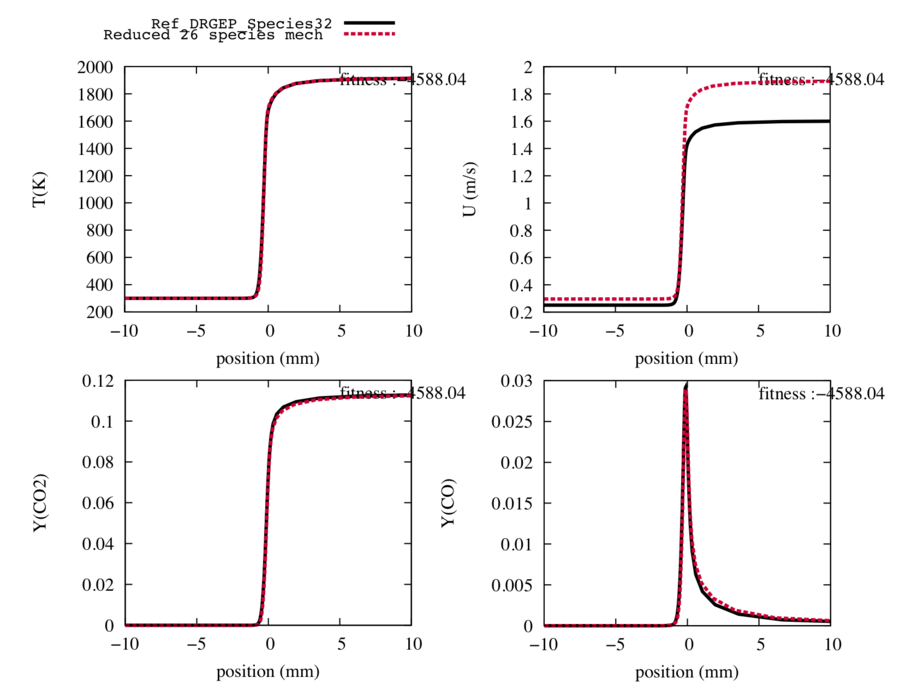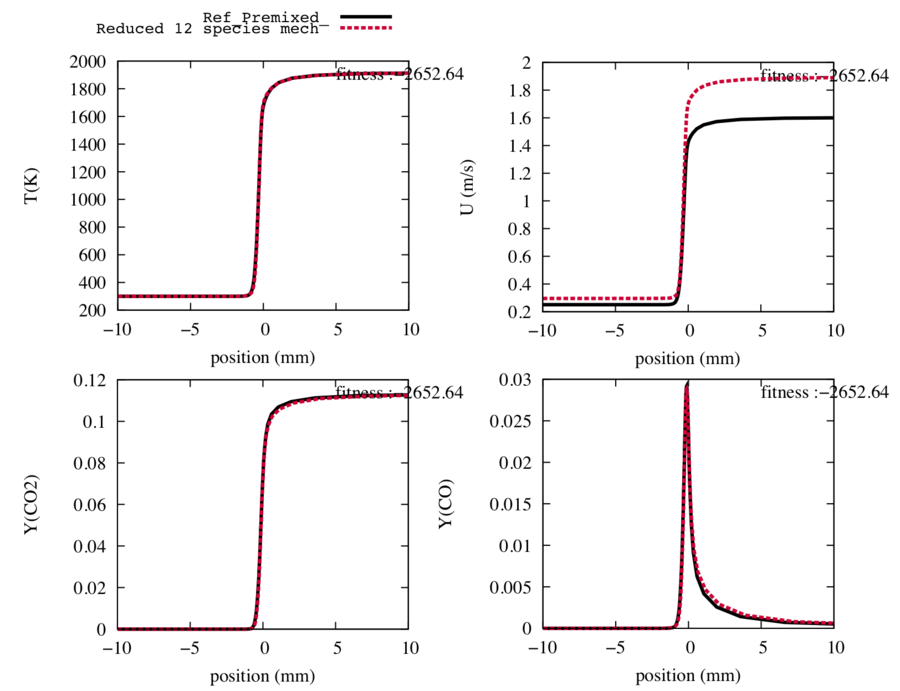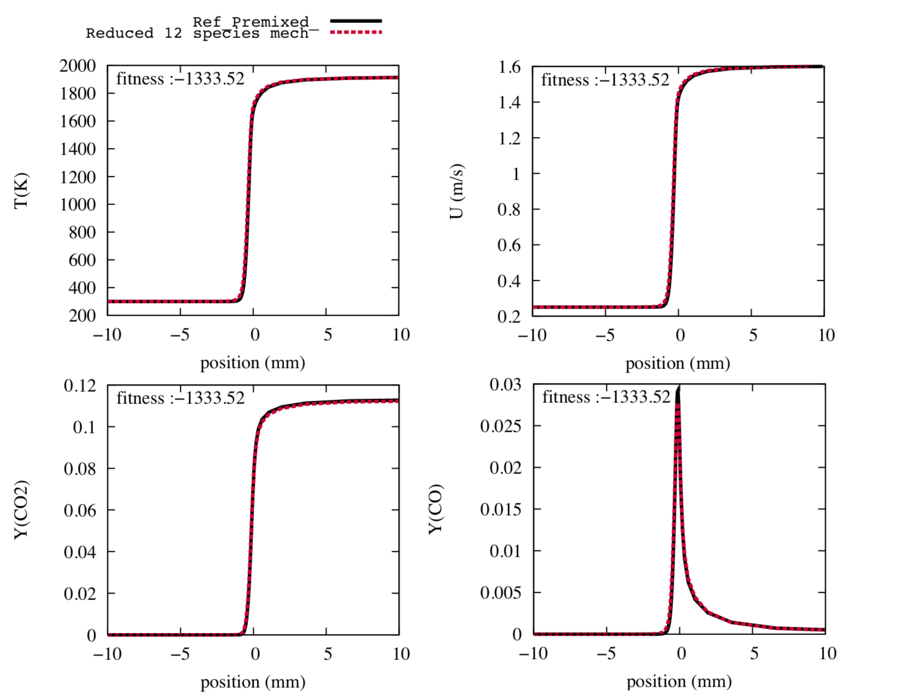Difference between revisions of "Premix CH 4/Air flame with scheme GRI12"
(→DRGEP step) |
(→DRGEP step) |
||
| Line 76: | Line 76: | ||
| − | From a detailed 32 species scheme, we obtain reduced schemes (31 to 14 species). and we choose the one with 14 species for the next step. | + | From a detailed 32 species scheme, we obtain reduced schemes (31 to 14 species). and we choose the one with 14 species for the next step because the shape of the velocity and species are conserved (and Cantera is unable to converge the 13-species scheme). |
[[File:DRGEPSpec_14Sp_42R_Premixed.png|900px|center]] | [[File:DRGEPSpec_14Sp_42R_Premixed.png|900px|center]] | ||
Revision as of 15:58, 31 January 2019
Contents
Objectives
The Stochastic_GRI12 test case describes a reduction of the GRI1.2 scheme for a 1D premixed flame. Starting with 32 species and 177 reactions, we reduce to 14 species and 26 reactions.
Key parameters
The target species considered for this test case are O2, CO and CO2. The characteristics of the premixed flame are displayed below :
listFlames.push_back(new PremixedFlames(/*T_fuel*/ 300,
/*T_ox*/ 300,
/*Pressure*/ 1E+05,
/*Ratio*/ 0.75,
/*Y_fuel*/ "CH4:1.0",
/*X_fuel*/ "",
/*Y_ox*/ "O2:0.21, N2:0.79",
/*X_ox*/ "",
/*reference_flame_path*/ "flames/flame__Phi_0_75__P_100000__T_300.cantera",
/*flame_path*/ "flames/flame"));
Results
DRGEP step
While running the DRGEP species step, your terminal should display the following information :
scheme : GRI12
number of species : 32
number of reaction : 177
reference flame : flames/flame__Phi_0_75__P_100000__T_300.cantera
Pressure : 1 bar
equivalence ration : 0.75
Composition : <O2:0.202024>
<CH4:0.0379821>
<N2:0.759994>
followed by the the species associated with their rank :
1.37642e-15 AR 2.12795e-06 HCCOH 4.32935e-05 C2H 0.000157543 CH2CO 0.000362521 C 0.000444401 C2H2 0.00101888 HCCO 0.00357515 C2H3 0.00398744 CH3OH 0.00409277 CH 0.00543294 CH2OH 0.0126485 C2H4 0.0126485 C2H5 0.0170844 CH2(S) 0.0190984 C2H6 0.0314311 CH2 0.0362943 H2O2 0.0844714 H2 0.0862782 CH3 0.105794 CH2O 0.110349 HCO 0.141159 H2O 0.150828 CH3O 0.218864 O 0.294638 HO2 0.48461 OH 0.48475 H 1 O2 1 CH4 1 CO 1 CO2 1 N2
From a detailed 32 species scheme, we obtain reduced schemes (31 to 14 species). and we choose the one with 14 species for the next step because the shape of the velocity and species are conserved (and Cantera is unable to converge the 13-species scheme).
Fig1 : Comparison between the reference trajectories of the target species, the temperature and the flame speed (in black), and the trajectories computed with the reduced mechanism with 14 transported species and 42 reactions, after a DRGEP species reduction (in red).
From the reduced scheme with 14 species, the DRGEP reaction step displays the associated 42 reactions (forward, reverse and global) with their rank :
Reaction 11 1.76836114590199e-05 Reaction 1 2.00306712724843e-05 Reaction 2 5.32560412611922e-05 Reaction 12 0.000199370652543748 Reaction 22 0.000203838178516555 Reaction 6 0.00205742513026953 Reaction 18 0.00214112144276709 Reaction 31 0.00256497802215946 Reaction 36 0.00423851339874798 Reaction 38 0.00628440315477067 Reaction 10 0.00709110759390656 Reaction 34 0.00727675619860293 Reaction 7 0.00816841794021552 Reaction 32 0.0105674795412113 Reaction 8 0.011392637948932 Reaction 37 0.0121416498847893 Reaction 25 0.0223800727572329 Reaction 24 0.0282453396822729 Reaction 29 0.0283685654460358 Reaction 13 0.0346772420107361 Reaction 9 0.0420990341989184 Reaction 5 0.0436190317079101 Reaction 19 0.052214327287295 Reaction 14 0.0559978780179485 Reaction 40 0.116797747919766 Reaction 3 0.119098963953184 Reaction 35 0.124498803353466 Reaction 26 0.139190739846114 Reaction 21 0.156522233136118 Reaction 30 0.159814723012322 Reaction 20 0.170817390107279 Reaction 39 0.1880142273317 Reaction 23 0.196350171114342 Reaction 4 0.216840758956933 Reaction 15 0.216904850055577 Reaction 42 0.233730982227189 Reaction 17 0.288086975041949 Reaction 27 0.28850598819427 Reaction 16 0.313186383157947 Reaction 33 0.436800577699977 Reaction 41 0.466945029846514 Reaction 28 0.467986201698403
After this step, by comparing the reference trajectories with the new ones, we choose to delete 16 reactions, so the next step is performed with 14 species and 26 reactions.
Fig2 : Comparison between the trajectories of the target species, the temperature and the flame speed computed with the reduced 14-species 42-reaction mechanism (in black) , and the trajectories computed with the reduced mechanism with 14 transported species and 26 reactions after a DRGEP reaction reduction (in red).
QSS step
The QSS step provides the QSS criteria of each species and the different links with the others species :
Species H 0.0581710482364302 Species O 0.0160759870785582 Species O2 0.277560360139677 Species OH 0.0144373005142915 Species H2O 0.314791474636433 Species HO2 0.010252726793236 Species CH3 0.100336627880574 Species CH4 0.79524736833312 Species CO 0.694064507028327 Species CO2 0.692897407440143 Species HCO 0.00243878401227475 Species CH2O 0.0772557856780877 Species CH3O 0.0207969879289909 Species N2 0
Interactions with species H with QSS Criteria 0.0581710482364302 HO2:2 CH3:1 CH2O:2 CH3O:1 N2:1
Interactions with species O with QSS Criteria 0.0160759870785582 OH:1 HO2:1 CH3:1 CH2O:1 CH3O:1
Interactions with species OH with QSS Criteria 0.0144373005142915 O:1 OH:2 HO2:1 CH3:2 HCO:2 CH2O:1 CH3O:1
Interactions with species HO2 with QSS Criteria 0.010252726793236 H:2 O:1 OH:1 CH3:1 CH2O:1 N2:1
Interactions with species CH3 with QSS Criteria 0.100336627880574 H:1 O:1 OH:2 HO2:1
Interactions with species HCO with QSS Criteria 0.00243878401227475 OH:2
Interactions with species CH2O with QSS Criteria 0.0772557856780877 H:2 O:1 OH:1 HO2:1
Interactions with species CH3O with QSS Criteria 0.0207969879289909 H:1 O:1 OH:1
Interactions with species N2 with QSS Criteria 0 H:1 HO2:1
We choose to put the species CH3O and HCO in QSS hypothesis due to their low QSS coefficient. The species HO2 could have been a good candidate too but it is linked to himself (non linearity).
In order to obtain the trajectories of the 14-species 26-reaction reduced scheme with these 2 species in QSS hypothesis, we run the getQSSfile step and we obtain the following graphs.We observe that the final state and the shape of the trajectories are conserved. It is under these conditions that the optimisation step will be efficient.
Fig3 : Comparison between the reference trajectories of the target species, the temperature and the flame speed (in black), and the trajectories computed with the reduced mechanism with 12 transported species and 26 reactions after a DRGEp reaction reduction (in red).
Optimisation
The final step of the ORCh method, the genetic algorithm, enables to recover the trajectories of the target species. Firstly, we allowed a 10 % variation on the pre exponential factor, the temperature exposant and 6 % on the energy activation in order to find their optimal values.
A population of 42 elements was used during 48 generations.
Secondly, in order to obtain more precise trajectories, we allowed a 1 % variation on the pre exponential factor, the temperature exposant and the energy activation. 34 more generations were performed in that case.
The following trajectories of the temperature, the flame speed and the target species match perfectly the ones of the reference detailed scheme with only 12 transported species and 26 reactions.
Fig4 : Comparison between the reference trajectories of the target species, the temperature and the flame speed (in black), and the trajectories computed with the reduced mechanism with 12 transported species and 26 reactions after optimisation (in red).



